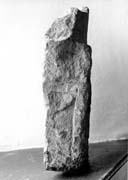Select a site alphabetically from the choices shown in the box below. Alternatively, browse sculptural examples using the Forward/Back buttons.
Chapters for this volume, along with copies of original in-text images, are available here.
Object type: Cross base or pillar base
Measurements: H. 46 < 48.5 cm (18 < 19 in); W. 42 < 46 cm (13 < 18 in); D. 13 < 15 cm (5 < 6 in) on face B; 8 cm (3 in) on face D
Stone type: Yellowish grey (5Y 7/2), dominantly mediumgrained, clast-supported, bioclastic oolite. Ooliths mostly well graded and in the range 0.3 to 0.5 mm diameter, but with some up to 0.8 mm; ooliths stand proud. Shell fragments sub-rounded to rounded; a few elongate fragments up to 2.5 mm. Portland stone, Portland Freestone Member, Portland Limestone Formation, Portland Group, Upper Jurassic
Plate numbers in printed volume: Pls. 50-6
Corpus volume reference: Vol 7 p. 100-1
(There may be more views or larger images available for this item. Click on the thumbnail image to view.)
The object consists of a rectangular base with only one complete face, a panel framing a four-legged beast with a narrower plain curved columnar feature above. Only one face is carved.
A (broad): The rounded upper section of the piece is broken, and cut back above the carved panel with a plain, smooth surface. The panel below (30.5 cm / 12 in high) is framed by broad rounded mouldings, but the deeper band at the top (which must originally have projected) has been hacked away. The interior of the panel behind the beast is smoothly finished and the animal is deeply cut, to a depth of 0.5 cm. The quadruped, which is shown in movement, fills the picture frame. Its back legs are tied by a heavy plant strand, one lobed coil of which dangles to the ground whilst another strand passes painfully through its body, and after emerging separates into three strands, one of which passes over its neck and around its front leg. It is not clear whether the strand which passes through its open frog-like mouth is meant to be a plant strand or another front leg. The beast has a reptilian head with prominent almond-shaped eyes with lightly marked pupils. Details of its head and feet, where they are not mutilated, are finely drawn.
B (narrow): No original surface of this side survives, although the division between the rectangular base and upper 'column' is visible.
C (broad): This side has been hacked away, leaving a sectioned squared socket. Traces of mortar cover the face.
D (narrow): Part of a recessed panel with broad mouldings survives. There appears to have been carving within the frame but it has been hacked away.
E (top): Broken
F (bottom): Concave and smooth, and possibly an original Surface
The form of this piece is difficult to reconstruct: the panel with the animal is complete, including its frame, and this seems to give one the width and height of the rectangular base since face F is smooth and could be original. The depth of the piece is however uncertain: the large rectangular socket on face C is not very deep in relation to its size, and if the base had been square it would have been more in proportion; but the height and the form of the smooth rounded projection above is uncertain and it could have been columnar or half columnar. Although the piece has been seen as the terminal knop of a mural cross or alternatively the transverse arm of a cross, the animal appears more acceptable in a horizontal position, and the large socket on the back could suggest the same orientation and that the stone was firmly anchored into place. In that case it could have been the base of a free-standing monument, or even part of a screen or baldachino.
The animal, however, does not appear to conform to any of the Evangelist symbol, bestiary or even zodiac types and so has no obvious religious significance. Animals of indeterminate type enmeshed in plant-scrolls however are found on crosses and in the context of churches elsewhere (see Melbury Osmond and its discussion, p. 106) and this fettered creature may represent the strength of evil bound. Whether by design or the ineptitude of the carver, the braced back legs and downbent head do give the beast a singularly tortured appearance, whilst the plant is notably dominating and confining.
The depiction of the animal and its enmeshing plantscrolls are the only means of dating this piece, and both have a certain ambiguity. As noted above, a single animal enmeshed in plant-scroll is found at Melbury Osmond (Ills. 82–3), and the rather indistinctive plant forms with rounded terminals are not unlike that piece. The reptilian head of the Cranborne animal is however quite different, and unlike animals in metalwork with which Melbury Osmond can be compared. This creature is more like the paired animals at the base of the Todber shaft (Ill. 110), or those on the terminals of manuscript letters, as for example Oxford, Bodl. Lib. Junius 27, fol. 136, which is dated to the mid-tenth century (Temple 1976, no.7, ill. 22). Kendrick considered the feature of 'penetration' whereby elements of scrolls pass through an animal body to be a ninth-century phenomenon, and noted it also at Ramsbury (Kendrick 1938, 145, 214; see Ills. 496, 510). In a later discussion (1947) he compared this carving with Codford St Peter (Ills. 425–8) and dated it to the ninth century. But there seems little affinity between this piece and Codford; the plant-scrolls cannot be related to either vine or acanthus forms, and although they are somewhat reminiscent of the derived acathus forms which surround the beast on the St Paul's churchyard slab (Tweddle et al. 1995, ill. 351), they seem best compared to Melbury Osmond (Ills. 82–3). This remains a tantalising piece from an important minster site.



